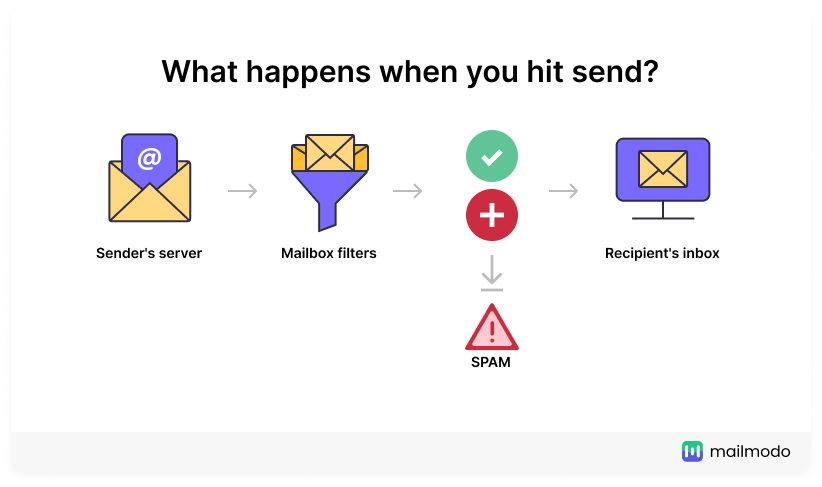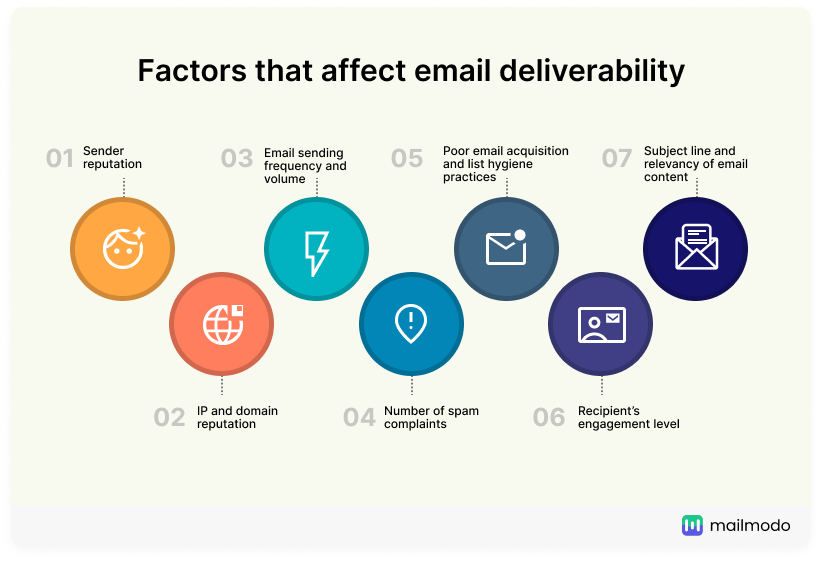In baseball, all your warmup practice goes in vain if you don't hit the ball. You only stand a chance to play and win if your bat hits the ball.
The same thing happens with email. Email campaigns are like that ball; if they're not landing in the inbox, all the investment in money, time, and effort will be fruitless.
So, landing in the recipient's inbox is the primary goal of assessing the performance of your email campaigns. It is known as email deliverability which we will be discussing in this article.
Table of contents
What is email deliverability?
Email deliverability refers to the number of emails that reached the subscriber's inbox and not the junk folder. One of the main goals of every email campaign is to have higher deliverability as only then other metrics, such as opens, clicks, etc., would matter.
Deliverability of your email campaigns rests in the hand of inbox providers (IBPs) like Gmail, Outlook, and Yahoo. If emails meet the protocols placed by IBPs, your emails will land in the primary tab keeping the deliverability high.
Often, marketers confuse deliverability with email delivery, but there is a difference.
Difference between email delivery and email deliverability
Email delivery
Email delivery tells you the number of emails that weren't bounced or rejected by the inbox provider. It gives the total number of emails sent versus emails delivered, no matter where they landed.
For example, if you sent 10,000 emails and 8000 got delivered, the email delivery rate will be 80%.
With this metric, you can see that 20% of emails were rejected or bounced. Of 80%, you won't be able to assess where those emails landed until you look at the email deliverability.
Email deliverability
This metric gives you much deeper insights into how many emails got in the recipient's inbox ditching the spam folder.
From the above example, out of 8000 emails, if 7000 got in the recipient's inbox, the deliverability rate will be 70%. It means 10% of emails landed in the spam or the promotion tab.
So, email deliverability gives you much deeper insights into how well your email campaigns performed. A higher delivery rate won't matter if your deliverability rate is lower.
How does email deliverability work?
Before we talk about the nitty-gritty of email deliverability, it's important to understand what happens after you click send.
When an email is sent from the sender's server, it must clear the getaway and the spam filters. Think of them as the gatekeeper of the recipient's mail server.
These filters assess the email for different factors like the legitimacy of the sender, authenticity of email content, domain reputation, etc.
Emails that pass all the checkboxes are delivered to the recipient's server in the inbox or promotion tab (applicable for Gmail users only). But, many get stuck in the process and are either rejected by the recipient's server or sent to the spam folder.

So, if your emails are making it to the inbox, Voila! With that in mind, let's discuss the most asked question.
What is a good email deliverability rate?
Globally, the average inbox placement rate was 83 percent in 2019, meaning one of every six messages failed to reach the inbox. - Validity's Email Deliverability Benchmark Report 2020
As per our State of Email Report 2022, average inbox placement ranges between 70-100% across industries.
So, a good email deliverability rate varies from industry to industry and email type. But if it goes below 70% it might be worth looking into.
Why is email deliverability important?
A good deliverability rate is non-negotiable to get a higher ROI from your email campaigns.
The first step towards conversion is getting in the inbox, and then comes the product, the copy you've written, and the design you've created. With the best design and copy, if you're not inboxing, your ROI will simply go for a toss.
Suryanarayan Pal, Growth Marketer, Mailmodo
All your money and time invested in setting up your email infrastructure, messaging, and email service provider is wasted without a solid reputation. So, monitoring your campaign's deliverability is critical to ensure you get a higher ROI.
Tracking the deliverability rate also helps you identify issues that might be limiting the exposure of emails to your target recipients.
Deliverability works like a ripple effect.
Lower open and engagement due to the bad deliverability of a single campaign won't have major long-term implications. But, continuous deliverability issues will impact your sender's reputation and email ROI.
What factors affect email deliverability?
ISPs are the judge of where to put emails, and if they find your email worthy, they'll land it in the subscriber's inbox. But, they consider many factors to make this decision. The most significant ones are discussed below:

1. Sender reputation
Sender reputation is a score assigned to each sender by an Internet service provider that sends email. The higher the score, the more ISPs will land emails in the recipient's inbox. If the sender's reputation falls below an acceptable threshold, ISPs will put your inbox in the spam folder or reject it altogether.
Different ISPs have their criteria to assess the sender's reputation, but some of the common criteria include:
The number of emails sent by the organization
How many recipients mark the organization's emails as spam, complain to the ISP, or unsubscribe from the email list?
How often do the emails hit the ISP's spam trap?
The blacklisting status of the organization's domain.
How many times do emails get bounced?
How does the recipient engage with the emails?
There are tools to measure the sender's reputation, including
2. IP and domain reputation
The numerical identifier of the server (sender) is known as the Internet Protocol (IP) address. A domain such as @mailmodo.com, @gmail.com, and @companyname.com is used to send emails and assess the domain's reputation.
The type of IP address you use - shared or dedicated will impact your deliverability.
For instance, if you use a dedicated IP, the sending activity and campaign performance of other senders will impact your deliverability. Besides, the volume, frequency, and engagement level all impact the domain's reputation. A lower IP or domain reputation signals IP to land your email in a spam folder.
Gmail spam filters also look at the envelope domain's reputation to decide if email should land in the inbox or spam.
Here's what Mailmodo and Moengage's deliverbaility experts have to say about right infrastructure and it's impact on deliverbaility.
3. Email sending frequency and volume
While setting up the email infrastructure, it's advised to warm up the IP. It's because Mailbox filters keep an eye over sending volume and frequency. If they see a sudden surge in emails sent from a domain, it will land your email in spam.
As for frequency must be consistent and consider what the user has opted-in. If they opted-in only for a weekly newsletter, sending promotional emails will increase your chances of landing in a spam.
4. Number of spam complaints
Spam complaints refer to the number of times a recipient marked an email as spam. Spam complaints can increase due to many reasons, including:
sending too frequency emails,
irrelevant emails, or
sending emails after unsubscription.
If emails get higher spam complaints, ISPs will take it as a negative sign and mark your future emails as spam.
5. Poor email acquisition list hygiene practices
Poor email acquisition strategies like
Purchasing email list
Running purchased email list through cleaning tools
Sending emails to disengaged or inactive users
Sending emails to users who have unsubscribed
Sending emails to non-existing, abandoned, wrong, or invalid email addresses
All these signals ISPs that you are not following the email list best practices for cleaning your email list.
Poor list hygiene affects your sender's reputation also by increasing your chance to hit spam traps which are email addresses to capture the spammers. If you keep hitting spam traps, your reputation will go downhill, and so will the deliverability.
💡 Related guide: How to Verify & Clean Email List to Maintain Email Hygiene
6. The behavior of recipients
If your emails are getting delivered to the inbox, that doesn't mean you will enjoy the same rate forever. Mailbox algorithms check the recipient's actions and behavior, including
Did they open the email?
Which links do they click on?
How long do they engage with the email?
Do they delete the email without opening it?
Are they unsubscribing from your emails?
A continuous negative engagement will accumulate over time signaling ISPs that your emails might not be relevant to the recipient. So, going forward, your emails will land in the junk folder.
7. The subject line and content of the emails
Among the big factors, the email content seems insignificant, but it still affects email deliverability.
Everything has an impact on deliverability, from your subject line and preheader text to the email footer. ISPs use spam filters to detect irrelevant or spammy content, which can land emails in the spam folder.
Some of the common things that impact deliverability include:
Spam trigger words' 100% FREE', 'Buy now
Link shorteners such as bit.ly
Using HTTP:// links instead of HTTPS://
Image-only emails without any text content
Use of all caps lock text
Too many special characters in the subject line like Buy now!! Limited deal !!
How to monitor and measure deliverability?
Here we have discussed a few easy steps you should take to track and measure the deliverability rate:
Use inbox placement & deliverability tools
Apart from ESP's insights, tools are available to help assess the health of your email program.
| Tool name | Features |
|---|---|
| Google postmaster | |
| MX toolbox | |
| Sparkpost's inbox tracker | |
| Spamhaus | Check if your IP is in the blacklist or not. |
Other things you should also track are:
Look for any DNS failure from the client's side as it causes changes to the authentication protocol.
Check if your email content aligns with the recipient's preferences and needs.
Check if you’re sending email at a rate with which the recipient can’t expect. Google Postmaster gives you a delivery error when you exceed the acceptable send limit.
Run email deliverability tests
There are a few tests you should run to keep track of the deliverability of email campaigns:
1. Seed list testing
Before running any email deliverability tests, seed list testing is essential. An email seed list will have validated and whitelisted email ids. You can send the emails on these ids before sending them to your recipients to check whether your emails are landing in the inbox.
It also enables you to test your email across different devices and email clients.
2. Content filtering testing
Filtering your email messages based on specific content filters using tools like SpamAssassin or Cloudmark is called content filter testing.
Email screening for malware, spam, and other malicious or undesirable content is done by scanning the email’s subject line and then forwarded via the content filtering system.
Whenever an email doesn’t pass the content filter test, it goes to the recipient’s junk folder. The chances are that the message will be sent back to the sender with a message 'undeliverable' in some cases.
3. Domain and IP blacklist testing
This testing helps check whether your domain and IP address is on the anti-spam database. The testing also includes checking domain and IP addresses and different blacklist providers to ensure your email deliverability is not affected.
4. Email authentication testing
This test verifies whether your emails are passing through authentication protocols - SPF, DKIM, and DMARC
This test checks if your IP address and the domain are on an anti-spam database. That involves checking IP addresses and domains across various blacklist providers to ensure your email lands in the recipient’s inbox.
💡 Related guide: Understanding Email Authentication Protocols: SPF, DMARC, and DKIM
Checklist to ensure higher email deliverability
Here we have discussed pre and post-send checklists to monitor the deliverability of email campaigns:
Pre-send deliverability checklist
• Check if your IP is on the block list.
Blocklist contains a list of all the spammy sender's IPs. Your deliverability will get affected if the IP is in that list. You can access this blocklist using tools like MXtoolbox and DNS checker.
All you have to do is enter your IP address, which will return with the results.
You might think your IP reputation is strong, but running it once won't hurt. In an analysis of 1.5 million tested emails, Litmus found that 70% of emails show at least one spam-related issue that may impact deliverability.
If you use a shared IP address, activities from other senders will impact your IP reputation. So, before you send your email marketing campaign, check the blacklist.
💡 Related guide: How Does IP Address Affect Your Email Deliverability
Post-send deliverability checklist
Measuring the exact deliverability might be tricky. But, you can watch certain signals to understand the trend of your deliverability rate and take contingent actions if it dips.
Some of these signals that you should monitor are as follows:
• Keep an eye over your email analytics
DMA's Email Deliverability 2020 report shows that marketers are measuring the following metrics to monitor email deliverability:
Emails bounced/ not bounced (50%),
Low engagement (44%),
Inbox placement (40%), and
Spam complaints too (29%)
David Bitton, Co-founder & CMO, DoorLoop gives the following advice when it comes to tracking a campaign's performance,
Pay special attention to any increases in unsubscribes and drops in engagement. These factors can be signs that your sending volume and frequency are no longer meeting your customers' needs and that you need to review your strategy.
Assessing the campaign's performance will help you detect issues faster. So, look for these metrics to see how well your campaign performs and where you need to improve.
13 effective ways to improve email deliverability
If your email deliverability takes a hit, here are 13 ways you can use to deal with the deliverability issue:
Authenticate your domain with SPF, DKIM, and DMARC
Setup Brand Indicators for Message Identification (BIMI)
Warmup your IP address
Keep a check on sender reputation and blacklists
Use double opt-in or confirmed opt-in
Don't use a purchased email lists
Clean your lists by suppressing inactive subscribers
Avoid spammy words in the subject line and email copy
Segment your email list to send relevant emails
Maintain a consistent sending frequency and schedule
Make it easy to unsubscribe
Send emails that people love to engage with
Track performance metrics and fix issues
We have discussed these points in detail in our guide on Improving email deliverability.
Improve deliverability with Mailmodo
Maintaining the right email deliverability is difficult but not impossible.
SBNRI, a fintech company, saw lower deliverability when they sent emails from a new domain. It resulted in a lower open rate and domain reputation.
When they reached out to our deliverability consultant, they found they had poor list hygiene and higher spam complaints, among other issues. So, our team helped them
Segment active contacts from their email list
Send daily warmup emails while maintaining the frequency and volume
Put all the invalid and bounced emails in a suppression list.
The Mailmodo expert assessed earlier campaigns sent and analyzed many email health parameters. With their support, we became aware of how to warm up a domain, maintain email list hygiene and manage a suppression list.
Muhet Gupta, Growth Manager, SBNRI
From setting up email authentication to measuring the campaign's performance, our email deliverability experts will assist you at every step. Wait no longer to improve your campaign's performance and land in your recipient's inbox.
What you should do next
Hey there, thanks for reading till the end. Here are 3 ways we can help you grow your business:
Talk to an email expert. Need someone to take your email marketing to the next level? Mailmodo’s experts are here for you. Schedule a 30-minute email consultation. Don’t worry, it’s on the house. Book a meet here.
Send emails that bring higher conversions. Mailmodo is an ESP that helps you to create and send app-like interactive emails with forms, carts, calendars, games, and other widgets for higher conversions. Get started for free.
Get smarter with our email resources. Explore all our knowledge base here and learn about email marketing, marketing strategies, best practices, growth hacks, case studies, templates, and more. Access guides here.


